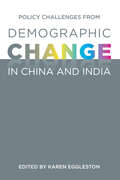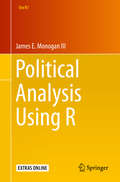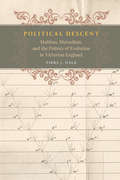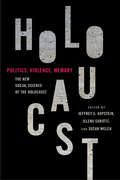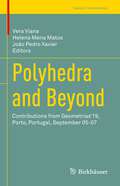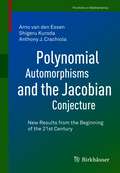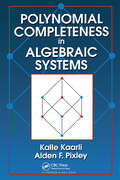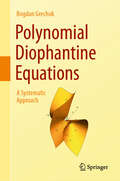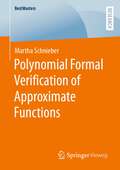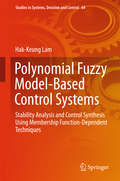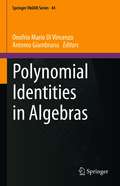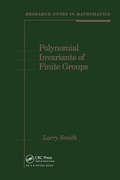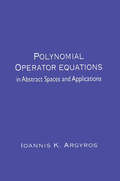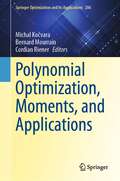- Table View
- List View
Pole Solutions for Flame Front Propagation
by Oleg KupervasserThis book deals with solving mathematically the unsteady flame propagation equations. New original mathematical methods for solving complex non-linear equations and investigating their properties are presented. Pole solutions for flame front propagation are developed. Premixed flames and filtration combustion have remarkable properties: the complex nonlinear integro-differential equations for these problems have exact analytical solutions described by the motion of poles in a complex plane. Instead of complex equations, a finite set of ordinary differential equations is applied. These solutions help to investigate analytically and numerically properties of the flame front propagation equations.
Policy Challenges from Demographic Change in China and India
by Karen EgglestonThe world's two most populous countries face numerous policy challenges from rapid demographic change, including gender imbalance, population aging, and rapid urbanization. Drawing on social science expertise from China, India, and the United States, the contributors examine the social and economic challenges for policy across a range of domains, from family planning and old-age support to human capital investment, poverty alleviation, and broader issues of governance. Sections focus on: Policy challenges and economic impact Fertility and sex imbalance Human capital and urbanization Population aging
Polish Families in Ireland: A Life Course Perspective
by Alicja Bobek Michelle ShareThis volume explores the family formation and life course of Polish people in Ireland, who make up the largest immigrant group in Ireland. Chapters address key dimensions of the life course in three parts focusing on childhood and youth, adulthood and parenting, and mid-life and futures. Contributions investigate the experiences of children and youth attending school and understanding their identities, the changing nature of families and family support, how families might engage with welfare institutions, and more. Through the life course approach, the book moves beyond the paradigm of studying the Polish population as economic migrants and instead analyzes and illustrates the lives of Polish families living in Ireland since EU enlargement.
Political Analysis Using R
by James E. MonoganThis book provides a narrative of how R can be useful in the analysis of public administration, public policy, and political science data specifically, in addition to the social sciences more broadly. It can serve as a textbook and reference manual for students and independent researchers who wish to use R for the first time or broaden their skill set with the program. While the book uses data drawn from political science, public administration, and policy analyses, it is written so that students and researchers in other fields should find it accessible and useful as well. By the end of the first seven chapters, an entry-level user should be well acquainted with how to use R as a traditional econometric software program. The remaining four chapters will begin to introduce the user to advanced techniques that R offers but many other programs do not make available such as how to use contributed libraries or write programs in R. The book details how to perform nearly every task routinely associated with statistical modeling: descriptive statistics, basic inferences, estimating common models, and conducting regression diagnostics. For the intermediate or advanced reader, the book aims to open up the wide array of sophisticated methods options that R makes freely available. It illustrates how user-created libraries can be installed and used in real data analysis, focusing on a handful of libraries that have been particularly prominent in political science. The last two chapters illustrate how the user can conduct linear algebra in R and create simple programs. A key point in these chapters will be that such actions are substantially easier in R than in many other programs, so advanced techniques are more accessible in R, which will appeal to scholars and policy researchers who already conduct extensive data analysis. Additionally, the book should draw the attention of students and teachers of quantitative methods in the political disciplines.
Political Descent: Malthus, Mutualism, and the Politics of Evolution in Victorian England
by Piers J. HaleHistorians of science have long noted the influence of the nineteenth-century political economist Thomas Robert Malthus on Charles Darwin. In a bold move, Piers J. Hale contends that this focus on Malthus and his effect on Darwin’s evolutionary thought neglects a strong anti-Malthusian tradition in English intellectual life, one that not only predated the 1859 publication of the Origin of Species but also persisted throughout the Victorian period until World War I. Political Descent reveals that two evolutionary and political traditions developed in England in the wake of the 1832 Reform Act: one Malthusian, the other decidedly anti-Malthusian and owing much to the ideas of the French naturalist Jean Baptiste Lamarck. These two traditions, Hale shows, developed in a context of mutual hostility, debate, and refutation. Participants disagreed not only about evolutionary processes but also on broader questions regarding the kind of creature our evolution had made us and in what kind of society we ought therefore to live. Significantly, and in spite of Darwin’s acknowledgement that natural selection was "the doctrine of Malthus, applied to the whole animal and vegetable kingdoms,” both sides of the debate claimed to be the more correctly "Darwinian. ” By exploring the full spectrum of scientific and political issues at stake, Political Descent offers a novel approach to the relationship between evolution and political thought in the Victorian and Edwardian eras.
Politicizing Asian American Literature: Towards a Critical Multiculturalism (Studies in Asian Americans)
by Youngsuk ChaeThis book examines U.S. multiculturalism from the perspective of Asian American writings, drawing contrasts between politically acquiescent multiculturalism and politically conscious multiculturalism. Chae discusses the works of writers who have highlighted a critical awareness of Asian Americans’ social and economic status and their position as 'unassimilable aliens', 'yellow perils', 'coolies', 'modern-day high tech coolies', or as a 'model minority', which were ideologically woven through the complex interactions of capital and labor in the U.S. cultural and labor history. Chae suggests that more productive means of analysis must be brought to the understanding of Asian American writings, many of which have been attempting to raise awareness of the politicizing effects of U.S. multiculturalism.
Politics, Violence, Memory: The New Social Science of the Holocaust
by Susan Welch Jeffrey S. Kopstein Jelena SubotićPolitics, Violence, Memory highlights important new social scientific research on the Holocaust and initiates the integration of the Holocaust into mainstream social scientific research in a way that will be useful both for social scientists and historians. Until recently social scientists largely ignored the Holocaust despite the centrality of these tragic events to many of their own concepts and theories. In Politics, Violence, Memory the editors bring together contributions to understanding the Holocaust from a variety of disciplines, including political science, sociology, demography, and public health. The chapters examine the sources and measurement of antisemitism; explanations for collaboration, rescue, and survival; competing accounts of neighbor-on-neighbor violence; and the legacies of the Holocaust in contemporary Europe. Politics, Violence, Memory brings new data to bear on these important concerns and shows how older data can be deployed in new ways to understand the "index case" of violence in the modern world.
Polly Shapes
by Amy TaoGo on an adventure with Polly as she learns how to use special names to categorize shapes! Any closed, flat shape with at least three straight sides is called a polygon. Did you know a quadrilateral—or a shape with four straight sides—can have several names? You can call one a parallelogram, a rhombus, a trapezoid, or even a square! What shapes can you recognize?
Polya Urn Models (Chapman & Hall/CRC Texts in Statistical Science)
by Hosam MahmoudIncorporating a collection of recent results, Polya Urn Models deals with discrete probability through the modern and evolving urn theory and its numerous applications. It looks at how some classical problems of discrete probability have roots in urn models. The book covers the Polya-Eggenberger, Bernard Friedman's, the Bagchi-Pal, and the Ehrenfest urns. It also explains the processes of poissonization and depoissonization and presents applications to random trees, evolution, competitive exclusion, epidemiology, clinical trials, and random circuits. The text includes end-of-chapter exercises that range from easy to challenging, along with solutions in the back of the book.
Polyadic Groups
by Wieslaw A. DudekThis book provides a general, unified approach to the theory of polyadic groups, their normal subgroups and matrix representations.The author focuses on those properties of polyadic groups which are not present in the binary case. These properties indicate a strong relationship between polyadic groups and various group-like algebras, as well as ternary Hopf algebras and n-Lie algebras that are widely used in theoretical physics.The relationships of polyadic groups with special types of binary groups, called covering groups and binary retracts, are described. These relationships allow the study of polyadic groups using these binary groups and their automorphisms.The book also describes the affine geometry induced by polyadic groups and fuzzy subsets defined on polyadic groups. Finally, we discuss the categories of polyadic groups and the relationships between the different varieties of polyadic groups. In many cases, we give elegant new proofs of known theorems. We also give many interesting examples and applications.The book contains many little-known results from articles previously published in hard-to-reach Russian, Ukrainian and Macedonian journals. These articles are not in English.
Polygons Galore: A Mathematics Unit for High-Ability Learners in Grades 3-5
by Marguerite M. Mason Clg Of William And Mary/Ctr Gift Ed Jill AdelsonPolygons Galore! is a mathematics unit for high-ability learners in grades 3-5 focusing on 2-D and 3-D components of geometry by exploring polygons and polyhedra and their properties. The van Hiele levels of geometric understanding provide conceptual underpinnings for unit activities. The unit consists of nine lessons that include student discovery of properties of polygons and polyhedra, investigations for finding areas of triangles and quadrilaterals, study of the Platonic solids, and real-world applications of polygons and polyhedra. It also includes activities related to identifying, comparing, and analyzing polygons by using properties of the polygons; constructing meanings for geometric terms; developing strategies to find areas of specific polygons; identifying and building regular and nonregular polyhedra; and recognizing geometric ideas and relationships as applied in daily life and in other disciplines, such as art.Grades 3-5
Polyhedra and Beyond: Contributions from Geometrias’19, Porto, Portugal, September 05-07 (Trends in Mathematics)
by Vera Viana João Pedro Xavier Helena Mena MatosThis volume collects papers based on talks given at the conference “Geometrias'19: Polyhedra and Beyond”, held in the Faculty of Sciences of the University of Porto between September 5-7, 2019 in Portugal. These papers explore the conference’s theme from an interdisciplinary standpoint, all the while emphasizing the relevance of polyhedral geometry in contemporary academic research and professional practice. They also investigate how this topic connects to mathematics, art, architecture, computer science, and the science of representation. Polyhedra and Beyond will help inspire scholars, researchers, professionals, and students of any of these disciplines to develop a more thorough understanding of polyhedra.
Polyhedral Methods in Geosciences (SEMA SIMAI Springer Series #27)
by Luca Formaggia Daniele Antonio Di Pietro Roland MassonThe last few years have witnessed a surge in the development and usage of discretization methods supporting general meshes in geoscience applications. The need for general polyhedral meshes in this context can arise in several situations, including the modelling of petroleum reservoirs and basins, CO2 and nuclear storage sites, etc. In the above and other situations, classical discretization methods are either not viable or require ad hoc modifications that add to the implementation complexity. Discretization methods able to operate on polyhedral meshes and possibly delivering arbitrary-order approximations constitute in this context a veritable technological jump. The goal of this monograph is to establish a state-of-the-art reference on polyhedral methods for geoscience applications by gathering contributions from top-level research groups working on this topic. This book is addressed to graduate students and researchers wishing to deepen their knowledge of advanced numerical methods with a focus on geoscience applications, as well as practitioners of the field.
Polyhedral and Algebraic Methods in Computational Geometry
by Michael Joswig Thorsten TheobaldPolyhedral and Algebraic Methods in Computational Geometry provides a thorough introduction into algorithmic geometry and its applications. It presents its primary topics from the viewpoints of discrete, convex and elementary algebraic geometry. The first part of the book studies classical problems and techniques that refer to polyhedral structures. The authors include a study on algorithms for computing convex hulls as well as the construction of Voronoi diagrams and Delone triangulations. The second part of the book develops the primary concepts of (non-linear) computational algebraic geometry. Here, the book looks at Gröbner bases and solving systems of polynomial equations. The theory is illustrated by applications in computer graphics, curve reconstruction and robotics. Throughout the book, interconnections between computational geometry and other disciplines (such as algebraic geometry, optimization and numerical mathematics) are established. Polyhedral and Algebraic Methods in Computational Geometry is directed towards advanced undergraduates in mathematics and computer science, as well as towards engineering students who are interested in the applications of computational geometry.
Polymers for Electronic Applications
by J.H. LaiThe object of this book is to review and to discuss some important applications of polymers in electronics. The first three chapters discuss the current primary applications of polymers in semiconductor device manufacturing: polymers as resist materials for integrated circuit fabrication, polyimides as electronics packaging materials, and polymers as integrated circuits encapsulates.
Polynomial Automorphisms and the Jacobian Conjecture: New Results from the Beginning of the 21st Century (Frontiers in Mathematics #190)
by Shigeru Kuroda Arno van den Essen Anthony J. CrachiolaThis book is an extension to Arno van den Essen's Polynomial Automorphisms and the Jacobian Conjecture published in 2000. Many new exciting results have been obtained in the past two decades, including the solution of Nagata's Conjecture, the complete solution of Hilbert's fourteenth problem, the equivalence of the Jacobian Conjecture and the Dixmier Conjecture, the symmetric reduction of the Jacobian Conjecture, the theory of Mathieu-Zhao spaces and counterexamples to the Cancellation problem in positive characteristic. These and many more results are discussed in detail in this work.The book is aimed at graduate students and researchers in the field of Affine Algebraic Geometry. Exercises are included at the end of each section.
Polynomial Completeness in Algebraic Systems
by Kalle Kaarli Alden F. PixleyThe study of polynomial completeness of algebraic systems has only recently matured, and until now, lacked a unified treatment. Polynomial Completeness in Algebraic Systems examines the entire field with one coherent approach. The authors focus on the theory of affine complete varieties but also give the primary known results on affine completeness in special varieties. The book includes an extensive introductory chapter that provides the necessary background and makes the results accessible to graduate students as well as researchers. Numerous exercises illustrate the theory, and examples-and counterexamples-clarify the boundaries of the subject.
Polynomial Diophantine Equations: A Systematic Approach
by Bogdan GrechukThis book proposes a novel approach to the study of Diophantine equations: define an appropriate version of the equation’s size, order all polynomial Diophantine equations by size, and then solve the equations in order. Natural questions about the solution set of Diophantine equations are studied in this book using this approach. Is the set empty? Is it finite or infinite? Can all integer solutions be parametrized? By ordering equations by size, the book attempts to answer these questions in a systematic manner. When the size grows, the difficulty of finding solutions increases and the methods required to determine solutions become more advanced. Along the way, the reader will learn dozens of methods for solving Diophantine equations, each of which is illustrated by worked examples and exercises. The book ends with solutions to exercises and a large collection of open problems, often simple to write down yet still unsolved. The original approach pursued in this book makes it widely accessible. Many equations require only high school mathematics and creativity to be solved, so a large part of the book is accessible to high school students, especially those interested in mathematical competitions such as olympiads. The main intended audience is undergraduate students, for whom the book will serve as an unusually rich introduction to the topic of Diophantine equations. Many methods from the book will be useful for graduate students, while Ph.D. students and researchers may use it as a source of fascinating open questions of varying levels of difficulty.
Polynomial Formal Verification of Approximate Functions (BestMasters)
by Martha SchnieberDuring the development of digital circuits, their functional correctness has to be ensured, for which formal verification methods have been established. However, the verification process using formal methods can have an exponential time or space complexity, causing the verification to fail. While exponential in general, recently it has been proven that the verification complexity of several circuits is polynomially bounded. Martha Schnieber proves the polynomial verifiability of several approximate circuits, which are beneficial in error-tolerant applications, where the circuit approximates the exact function in some cases, while having a lower delay or being more area-efficient. Here, upper bounds for the BDD size and the time and space complexity are provided for the verification of general approximate functions and several state-of-the-art approximate adders.
Polynomial Fuzzy Model-Based Control Systems
by Hak-Keung LamThis book presents recent research on the stability analysis of polynomial-fuzzy-model-based control systems where the concept of partially/imperfectly matched premises and membership-function dependent analysis are considered. The membership-function-dependent analysis offers a new research direction for fuzzy-model-based control systems by taking into account the characteristic and information of the membership functions in the stability analysis. The book presents on a research level the most recent and advanced research results, promotes the research of polynomial-fuzzy-model-based control systems, and provides theoretical support and point a research direction to postgraduate students and fellow researchers. Each chapter provides numerical examples to verify the analysis results, demonstrate the effectiveness of the proposed polynomial fuzzy control schemes, and explain the design procedure. The book is comprehensively written enclosing detailed derivation steps and mathematical derivations also for readers without extensive knowledge on the topics including students with control background who are interested in polynomial fuzzy model-based control systems.
Polynomial Identities in Algebras (Springer INdAM Series #44)
by Onofrio Mario Di Vincenzo Antonio GiambrunoThis volume contains the talks given at the INDAM workshop entitled "Polynomial identites in algebras", held in Rome in September 2019. The purpose of the book is to present the current state of the art in the theory of PI-algebras. The review of the classical results in the last few years has pointed out new perspectives for the development of the theory. In particular, the contributions emphasize on the computational and combinatorial aspects of the theory, its connection with invariant theory, representation theory, growth problems. It is addressed to researchers in the field.
Polynomial Invariants of Finite Groups
by Larry SmithWritten by an algebraic topologist motivated by his own desire to learn, this well-written book represents the compilation of the most essential and interesting results and methods in the theory of polynomial invariants of finite groups. From the table of contents: - Invariants and Relative Invariants - Finite Generation of Invariants - Constructio
Polynomial Operator Equations in Abstract Spaces and Applications
by Ioannis K. ArgyrosPolynomial operators are a natural generalization of linear operators. Equations in such operators are the linear space analog of ordinary polynomials in one or several variables over the fields of real or complex numbers. Such equations encompass a broad spectrum of applied problems including all linear equations. Often the polynomial nature of many nonlinear problems goes unrecognized by researchers. This is more likely due to the fact that polynomial operators - unlike polynomials in a single variable - have received little attention. Consequently, this comprehensive presentation is needed, benefiting those working in the field as well as those seeking information about specific results or techniques. Polynomial Operator Equations in Abstract Spaces and Applications - an outgrowth of fifteen years of the author's research work - presents new and traditional results about polynomial equations as well as analyzes current iterative methods for their numerical solution in various general space settings.Topics include:Special cases of nonlinear operator equationsSolution of polynomial operator equations of positive integer degree nResults on global existence theorems not related with contractionsGalois theoryPolynomial integral and polynomial differential equations appearing in radiative transfer, heat transfer, neutron transport, electromechanical networks, elasticity, and other areasResults on the various Chandrasekhar equationsWeierstrass theoremMatrix representationsLagrange and Hermite interpolationBounds of polynomial equations in Banach space, Banach algebra, and Hilbert spaceThe materials discussed can be used for the following studiesAdvanced numerical analysisNumerical functional analysisFunctional analysisApproximation theoryIntegral and differential equation
Polynomial Optimization, Moments, and Applications (Springer Optimization and Its Applications #206)
by Bernard Mourrain Michal Kočvara Cordian RienerPolynomial optimization is a fascinating field of study that has revolutionized the way we approach nonlinear problems described by polynomial constraints. The applications of this field range from production planning processes to transportation, energy consumption, and resource control.This introductory book explores the latest research developments in polynomial optimization, presenting the results of cutting-edge interdisciplinary work conducted by the European network POEMA. For the past four years, experts from various fields, including algebraists, geometers, computer scientists, and industrial actors, have collaborated in this network to create new methods that go beyond traditional paradigms of mathematical optimization. By exploiting new advances in algebra and convex geometry, these innovative approaches have resulted in significant scientific and technological advancements. This book aims to make these exciting developments accessible to a wider audience by gathering high-quality chapters on these hot topics.Aimed at both aspiring and established researchers, as well as industry professionals, this book will be an invaluable resource for anyone interested in polynomial optimization and its potential for real-world applications.
Polynomial Rings and Affine Algebraic Geometry: PRAAG 2018, Tokyo, Japan, February 12−16 (Springer Proceedings in Mathematics & Statistics #319)
by Gene Freudenburg Shigeru Kuroda Nobuharu OnodaThis proceedings volume gathers selected, peer-reviewed works presented at the Polynomial Rings and Affine Algebraic Geometry Conference, which was held at Tokyo Metropolitan University on February 12-16, 2018. Readers will find some of the latest research conducted by an international group of experts on affine and projective algebraic geometry. The topics covered include group actions and linearization, automorphism groups and their structure as infinite-dimensional varieties, invariant theory, the Cancellation Problem, the Embedding Problem, Mathieu spaces and the Jacobian Conjecture, the Dolgachev-Weisfeiler Conjecture, classification of curves and surfaces, real forms of complex varieties, and questions of rationality, unirationality, and birationality. These papers will be of interest to all researchers and graduate students working in the fields of affine and projective algebraic geometry, as well as on certain aspects of commutative algebra, Lie theory, symplectic geometry and Stein manifolds.

